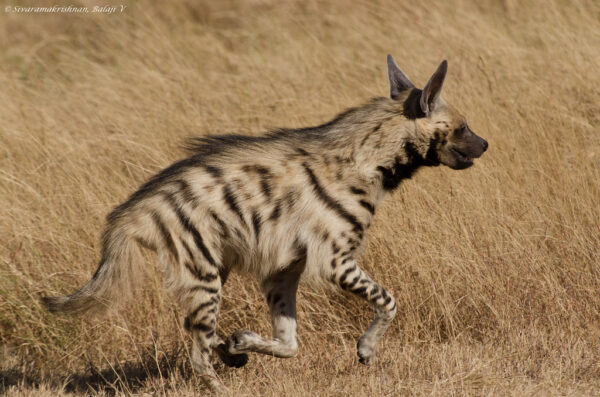Scientific Classification
- Kingdom: Animalia
- Phylum: Chordata
- Class: Mammalia
- Order: Carnivora
- Family: Hyaenidae
- Genus: Hyaena
- Species: H. hyaena
Sub Species
The striped hyena is a monotypic species, meaning it doesn’t have recognized subspecies.
Related Animals
- Brown Hyena (Hyaena brunnea)
- Spotted Hyena (Crocuta crocuta)
- Aardwolf (Proteles cristatus)
Population Size
Currently, it is estimated that there are between 5,000 to 14,000 striped hyenas in the wild.
Physical Characteristics
- Lifespan: Up to 12 years in the wild, 23 years in captivity
- Top Speed: 60 km/h (37 mph)
- Weight: 22-55 kg (48-121 lb)
- Height: 70-80 cm (27.5-31.5 in) at the shoulder
- Length: 1-1.2 m (3.3-3.9 ft) head to body length
Coloration
Striped hyenas have a coarse fur that is primarily grey or beige, with black vertical stripes across their body and legs, and a black stripe down the midline of their head.
Diet
They are primarily scavengers, feeding on carrion, but will occasionally hunt small animals, fruits, and insects.
Geographical location/Range
Striped hyenas are found across North and East Africa, the Middle East, the Caucasus, Central Asia, and the Indian subcontinent.
Habitat and Biome
They inhabit a variety of ecosystems, including grasslands, woodlands, savannas, and desert edges.
Climate Zone
Striped hyenas are adaptable and can live in both temperate and tropical climates.
Group Name and Behavior
The group is known as a ‘cackle.’ Striped hyenas are typically solitary or live in small family groups.
Reproductive Details
- Age of Sexual Maturity: 2-3 years
- Male: Male
- Female: Female
- Young/Offspring: Cub
- Reproduction Season: Throughout the year, with a peak in spring and summer
- Gestation Period: 90-91 days
- Type of Birth: Viviparous (live birth)
- Age of Weaning: 12 months
Conservation Status
The International Union for Conservation of Nature (IUCN) lists the striped hyena as a ‘Near Threatened‘ species.
General Description
The striped hyena, a nocturnal animal, is known for its scavenging habits. Its distinct appearance and unique characteristics have made it an important animal in many cultures’ folklore and mythology.
Appearance
The striped hyena possesses a robust build, with long hair forming a mane down its back that can stand erect when threatened. Its grey or beige body is adorned with black stripes, giving it its name.
Geographical Distribution
The striped hyena has a wide distribution, from Africa to Asia. Despite being the most widespread hyena species, it’s often elusive and difficult to spot in the wild.
Habit and Lifestyle
Striped hyenas are nocturnal, foraging alone or in small family groups. They use dens for shelter and rest, often inhabiting dens abandoned by other animals.
Diet and Nutrition
As scavengers, striped hyenas primarily consume carrion. They also supplement their diet with small mammals, birds, fruits, and insects.
Mating Habits
Striped hyenas mate throughout the year, with peaks in spring and summer. They form monogamous pairs, and both parents participate in raising the young.
Population Status
Striped hyenas are listed as ‘Near Threatened’ by the IUCN due to habitat loss and persecution by humans. They are often seen as a menace to livestock, leading to conflicts with local communities. However, as scavengers, they play an important ecological role by consuming carrion and controlling disease spread.
Interesting Facts
- Striped hyenas can eat a significant amount of bone and even digest it.
- In some cultures, they are considered to have magical powers.
- They have the strongest jaws in relation to body size among Carnivora, powerful enough to crush bones.
AZA Zoos with Striped Hyenas
Several zoos accredited by the Association of Zoos and Aquariums (AZA) house the striped hyena, including:
- San Diego Zoo, California
- Smithsonian National Zoological Park, Washington D.C.
- Cincinnati Zoo and Botanical Garden, Ohio

